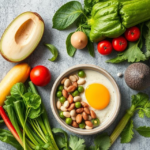Do you ever find yourself craving a specific food, such as chocolate, cheese, or pizza, even when you are not hungry? Do you ever wonder why you have these intense desires for certain foods and how you can control them? If so, you are not alone. Food cravings are extremely common, affecting more than 90% of people. However, food cravings can also be problematic, as they can lead to overeating, weight gain, and poor health outcomes. In this blog post, we will explore some of the science behind food cravings and what you can do to manage them.
What are food cravings and what causes them?
A food craving is defined as a powerful desire for a specific food. This desire can seem uncontrollable and may cause a person to crave typically unhealthy foods, such as processed and highly palatable foods that are high in sugar, salt, and fat. Food cravings are different from hunger, which is a physiological need for food. Hunger can be satisfied by any food, whereas cravings are selective and specific.
The causes of food cravings are complex and multifactorial, involving biological, psychological, and environmental factors. Some of the main mechanisms that contribute to food cravings are:
- Brain reward system. Certain foods, especially processed and highly palatable ones, stimulate the neurons in the reward region of the brain, creating positive feelings of pleasure and motivation to seek these foods regularly. These foods also trigger the release of dopamine, a neurotransmitter that is involved in reward and reinforcement learning. Dopamine signals to the brain that a certain food is rewarding and worth repeating. Over time, this can create a strong association between a specific food and a positive outcome, leading to cravings for that food.
- Hormones. Hormones can also influence food cravings by affecting appetite, mood, and stress levels. For example, leptin is a hormone that regulates energy balance by signaling to the brain when the body has enough stored fat. However, when a person consumes too much sugar or fat, their leptin levels can become imbalanced, leading to leptin resistance. This means that the brain does not receive the signal that the body is full and needs to stop eating, resulting in increased hunger and cravings. Another example is serotonin, a hormone that regulates mood and well-being. Low levels of serotonin can cause depression, anxiety, and irritability, which can trigger emotional eating and cravings for comfort foods.
- Emotions. Emotions can also play a role in food cravings, especially in cases of stress or emotional eating. Stress can interfere with self-control, spike hormones that make you feel hungry, and increase your cravings for comforting foods, such as sweets or carbs. Emotional eating is a coping strategy that some people use to deal with negative emotions, such as sadness, anger, boredom, or loneliness. Eating certain foods can temporarily soothe these emotions by stimulating the brain reward system and releasing endorphins. However, this can also create a vicious cycle of guilt, shame, and more negative emotions that fuel more emotional eating and cravings.
- Habits. Habits are behaviors that are repeated frequently and automatically in response to certain cues or triggers. Habits can also influence food cravings by creating learned associations between specific foods and situations or contexts. For example, if you always eat popcorn when you watch a movie, or ice cream when you have a bad day, or chocolate when you feel stressed, you may develop a habit of craving these foods whenever you encounter these scenarios. Habits can be hard to break, but they can also be changed or replaced with healthier ones.
How can you manage your food cravings?
Food cravings can be challenging to overcome, but there are some strategies that can help you cope with them and make healthier choices. Here are some tips to help you manage your food cravings:
- Identify your triggers. The first step to managing your food cravings is to identify what triggers them in the first place. Is it stress, boredom, sadness, or anger? Is it a certain time of day, place, or person? Is it a specific food or smell? Once you know what triggers your cravings, you can try to avoid or minimize your exposure to these triggers, or find alternative ways to cope with them. For example, if you crave chocolate when you feel stressed, you can try to reduce your stress levels by practicing relaxation techniques, such as deep breathing, meditation, or yoga. Or if you crave popcorn when you watch a movie, you can try to watch something else that does not remind you of popcorn, or snack on something healthier, such as carrot sticks or apple slices.
- Delay your response. Another strategy to manage your food cravings is to delay your response to them. Instead of giving in to your craving right away, try to wait for 10 minutes and see if the craving subsides or changes. During this time, you can distract yourself with something else that engages your attention, such as reading a book, calling a friend, or doing a crossword puzzle. You can also drink some water or chew some gum to keep your mouth busy and hydrated. Sometimes, cravings are just a sign of thirst or boredom, and they can go away after a while.
- Savor your food. If you decide to indulge in your craving, make sure to do it mindfully and savor every bite of your food. Eating mindfully means paying attention to the appearance, smell, texture, flavor, and sensation of your food, and eating slowly and without distractions. Eating mindfully can help you enjoy your food more and feel more satisfied with less. It can also help you notice when you are full and stop eating before you overeat.
- Plan ahead. Planning ahead can also help you manage your food cravings by preventing hunger and temptation. Hunger can make you more susceptible to cravings and impulsive eating, so make sure to eat regular meals and snacks that are balanced and nutritious. Include foods that are high in protein, fiber, and healthy fats, such as eggs, yogurt, nuts, seeds, fruits, vegetables, and whole grains. These foods can help keep your blood sugar levels stable and your appetite under control. Also, plan ahead for situations where you might encounter cravings or temptations, such as parties, restaurants, or holidays. You can bring your own healthy snacks, choose smaller portions, share your dessert, or limit your alcohol intake. You can also prepare some healthy alternatives for your favorite foods, such as dark chocolate instead of milk chocolate, baked sweet potato fries instead of regular fries, or homemade pizza with whole wheat crust and low-fat cheese instead of takeout pizza.
Conclusion
Food cravings are common and normal, but they can also be problematic if they lead to overeating, weight gain, and poor health outcomes. Food cravings are influenced by various factors, such as brain reward system, hormones, emotions, and habits. Understanding the science behind food cravings and implementing some strategies to cope with them can help you make healthier food choices and maintain a balanced and nutritious diet.
I hope this blog post has helped you understand the science behind food cravings and how to manage them. If you have any questions or comments, please feel free to leave them below. Thank you for reading!






